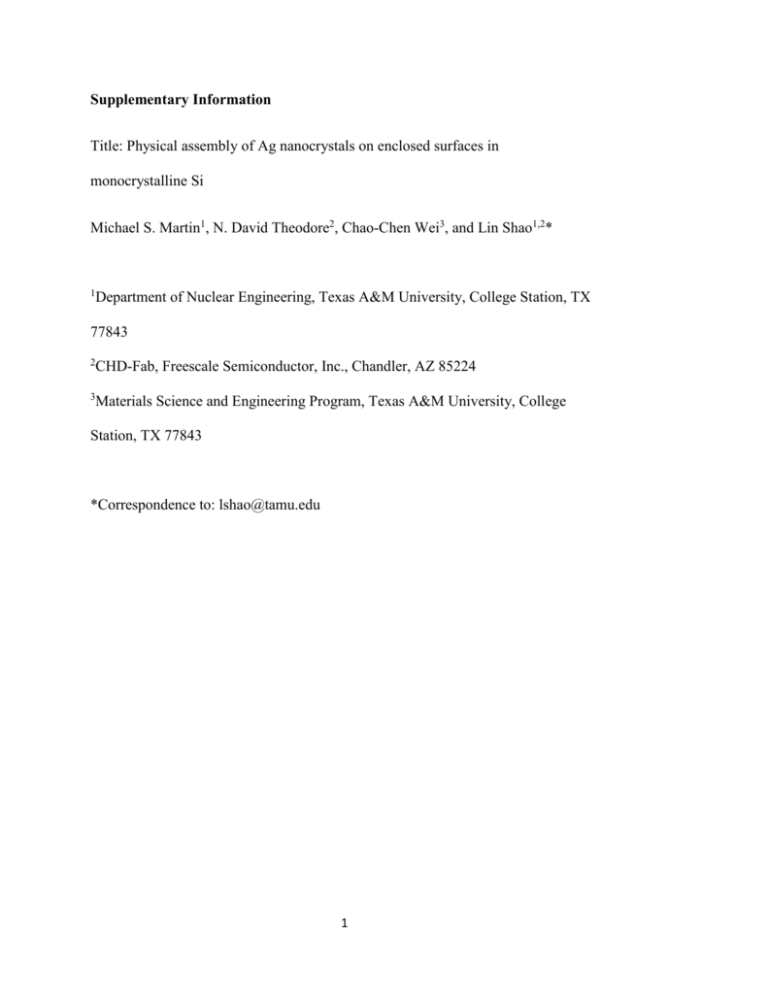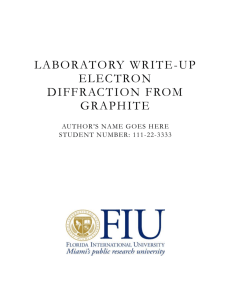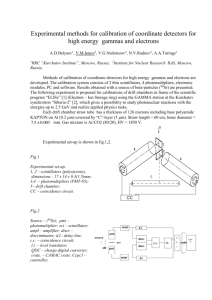Supplementary Information Title: Physical assembly of Ag
advertisement

Supplementary Information Title: Physical assembly of Ag nanocrystals on enclosed surfaces in monocrystalline Si Michael S. Martin1, N. David Theodore2, Chao-Chen Wei3, and Lin Shao1,2* 1 Department of Nuclear Engineering, Texas A&M University, College Station, TX 77843 2 CHD-Fab, Freescale Semiconductor, Inc., Chandler, AZ 85224 3 Materials Science and Engineering Program, Texas A&M University, College Station, TX 77843 *Correspondence to: lshao@tamu.edu 1 Supplementary Information: Direct evidence of the 4:3 co-incident site lattice relationship between Si(111) and Ag(111) is shown in Fig. S1. The nanocrystals are observed in a specimen fabricated by irradiation with 5×1015/cm2 100 keV He ions, annealing for 60 minutes at 950°C in flowing UHP Ar gas, deposition of 100 nm Ag, and heat treatment for one hour at 750°C in flowing UHP Ar gas. This specimen is also displayed in Figs. 1f, 2d and 3. A nanocrystals with side lengths ~15 nm is imaged near the [110] zone axis in Fig. S1a, and the portion in the white box is shown in greater detail in Fig. S1b. Silver and silicon lattice planes in the nanocrystal are marked by orange and red lines, respectively. Yellow dashed lines parallel to Ag lattice planes (orange lines) extend to show the mis-alignment with Si lattice planes (red lines). There are roughly three Si atomic plane spacings for every four Ag atomic plane spacings. Investigation of dislocations by TEM in three samples is shown in Fig. S2. The investigated samples are prepared with varying defect annealing times at 950°C, 30, 60, and 90 minutes for a, b, and c, respectively, with fixed diffusion heat treatment of one hour at 750°C. The total length of dislocations decreases with increasing defect annealing. In the three samples shown in Fig. S2, trapped Ag concentration increases from S2a to b before falling off precipitously in c, according to Fig. 2e. The remaining small amount of trapped Ag in Fig. S2c appears to be trapped in small nanoparticle clusters around dislocations or dislocation loops. Additional investigation will be undertaken in the future in order to determine the kinetics of Ag nanocrystal dissolution. 2 Fig. S1: Heteroepitaxial relationship between Si and Ag (111) atomic planes. a Ag nanocrystal embedded in Si with b top corner showing four atomic planes of Ag are aligned with three atomic planes of Si. 3 Fig. S2: A few areas of strain contrast indicating dislocations in the region containing voids/nanocrystals. Samples prepared by void formation annealing for a 30, b 60, or c 90 minutes at 950C and diffusion heat treatment at 750C for one hour. Fewer dislocations are observed with increasing void formation annealing time. In c, small nanoparticles are clustered around some of the remaining dislocations. 4 Fig. S3 shows TEM and electron diffraction investigation of a large Ag nanocrystal. The specimen was fabricated by 100 keV He ion irradiation to fluence 5×1015/cm2, followed by annealing at 950°C for 3.5 hours, followed by 100 nm Ag film by physical vapor deposition, followed by diffusion heat treatment at 750°C for two hours. The striking double diffraction patterns in Fig. S2 show that Ag and Si exist in their pure forms, and measured atomic spacings are within a few percent of tabulated values. All observed planes of Ag and Si are parallel with the exception of the Ag (100) atomic planes shown in Fig. S3c and d, which indicate the Ag unit cell is slightly non-cubic. This figure is included because the slight increase in size (from ~20 nm side lenghts in Figs. 3 and 4 to ~35 nm side lengths in Fig. S3) roughly quintuples the volume of the nanocrystal, meaning there are a sufficient number of Ag atoms to obtain a diffraction pattern from a low-index zone axis. The authors refrain from drawing any conclusions from this isolated specimen other than the inference that parallel Moire interference observed in Figs. 3 and 4 (of the main article) sufficiently demonstrate that pure fcc Ag exists and that no Ag-Si compounds are formed. Figure S4 shows the portion of micrograph in Fig. S3c marked with white dashed lines that has been Fourier filtered to show Moire interference fringe. The observed fringe spacing of 5.6 agrees well with calculated fringe spacing for parallel Si and Ag (110) atomic planes. 5 Fig. S3: a High-resolution transmission electron micrograph and b diffraction pattern obtained with the electron beam along the [011] zone axis, and c and d are of the same nanoparticle along the [100] zone axis. Diffraction patterns b and d have brightness, contrast and gamma slightly increased (to 0.55 or less from 0.50) to enhance lowintensity reflections. Dashed and solid circles indicate reflections from Si and Ag, respectively, and yellow, red and blue indicate reflections of (100), (110) and (111) families of planes, respectively, in b and d. 6 Figure S4: Portion of high-resolution micrograph in Fig. S3c, outlined by white dashed lines, filtered by Fourier transformation and masking, showing interference fringes of Si and Ag(110) planes with a spacing of 5.6 Å. 7









